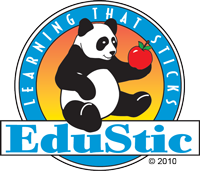All Three EduStic Games Win 2013 Tillywig Toy Brain Child Awards!
Thanks to all who played EduStic games at ChiTag 2012!
November 28, 2012Pattern Smart Receives High Marks from the National Lekotek Center and Able Play
February 6, 2013EduStic is proud to announce that all three of its games recently won 2013 Tillywig Toy Brain Child Awards. Hooray! According to Dan Levy, coordinator of the Tillywig Awards program, the Brain Child Award is given to “exciting products that energize the mind while seamlessly blending fun and learning.” Tillywig bases its awards on a variety of criteria, including: ease of first use, replay value, quality, fun factor, creativity, and motor skills. Products are evaluated in a focused group format with players and observers encompassing a broad range of ages. Tillywig called Pattern Smart “endlessly engaging, highly stimulating entertainment for all ages.” About Tangram Smart: It’s “full of action, with all players in on the fun, from start to finish.” And of Guess What!: “One of the things that makes this game so fun is that even when it’s not your turn, you’re as much a part of the action as if it were.” Go to the Tillywig Toy Awards site to get the complete reviews of our games. Or, read the reviews below. Happy playing!
Guess What!
Playing Guess What! develops a variety of aptitudes and skills (critical thinking, mathematics, pattern and shape recognition, among others). One of the things that makes Guess What! such fun is that even when it’s not your turn, you’re as much a part of the action as if it were. One player is the designated builder whose task it is to build an object indicated on a card just flipped from the top of the card deck. The builder uses colored geometric shapes placed on a laminated playboard. If one of the other players correctly guesses the object before time runs out (did we mention there’s a two minute timer?), both he and the builder receive two scoring discs. The guessing players frequently call out guesses, with the builder responding ‘Yes’ or ‘No.’ It is very much a group enterprise, with all players actively engaged from start to finish. The main deck of cards contains the names of 6 objects per card, each numbered so that a roll of the die determines which of the 6 to build. For players who prefer to have a visual model to work from, there is also a Junior deck whose cards show an image of the object to be built, constructed of the geometric pieces. The player with the most disks at the end of 5 rounds wins. For 3 to 8 players.
Pattern Smart
The human brain has an amazing capacity for recognizing and predicting patterns. Pattern Smart uses and cultivates that ability beautifully, helping players develop geometric aptitude, critical thinking skills, and math confidence. This rousing action-packed competition involves rounds of play during which all players race one another to complete a pattern from a flipchart, using shape tiles. The patterns come in three distinct levels of difficulty and become progressively harder as you move through the flipchart. The tiles (triangles, squares, hexagons, trapezoids, and rhombuses) are color-coded, aiding in shape recognition and the construction of patterns. The first player finished earns 10 points if correct or -10 points if he has made any errors. All other players receive -1 point for each piece missing from their pattern. The player with the highest score after 5 rounds wins. There are a couple of excellent game variations included, making for endlessly engaging, highly stimulating entertainment for all ages. For 1 to 3 players.
Tangram Smart
Here we have another great game from Edustic that’s full of action, with all players in on the fun from start to finish. In a head-to-head race, players use simple geometric shapes to create an animal, object, or number shown on a flipchart. The shapes come from the famous seven-piece Chinese tangram puzzle. That these simple geometric shapes can be used to form such a vast variety of creatures and objects is astonishing. The first player to complete the puzzle earns seven points, while the other players lose a point for each tile missing from theirs. Tangram Smart helps develop math confidence, geometric skills, critical thinking, prediction, spatial rotation, and in an added twist, language skills! Each page in the flipchart booklet also shows the Spanish, French, and Chinese word for the object, animal, or number to be created, and part of the game play is to discuss these translations. One game variation even allows points to be stolen based on language skills. The player with the most points after five rounds wins the game. For 1 to 4 players.

